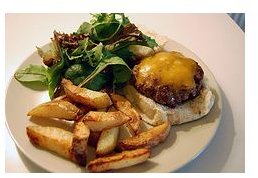Restaurant Menu Design: Tips for a Great Menu
Scope the Field
Don’t be afraid to check out other restaurants’ menus, especially if you’re going to be competing with them. See what elements you like or dislike about yours, and think about how you would like to stand apart from your competition. Not to mention, this will also give you a good idea of how to price your items fairly in comparison to your competitions. After all, if they’re charging two dollars for a hamburger, it would be unwise to charge six dollars for one at your restaurant.
Image Credit: Image by su-lin
The Font Factor
When choosing fonts, make sure that you pick something that is readable. While everyone loves an artistic font, something that is simple, well designed, and readable will be be a better choice in the long run. After all, people need to be able to read what they are ordering, otherwise you probably won’t do very good business with them!
Color Theory
Color design is important! What kind of a restaurant are you running? Diners often sport colors of red, white, and blue as they offer the quintessential American cuisine. Fancier restaurants tend to use deep jewel tones, Italian restaurants use the golds, greens, and oranges that Italy is known for. Sports bars often showcase classic primary colors like those used in sports logos. The colors on your menu are up to you, but try to remember that you need to prize readability above all else. If you’re not entirely sure what the symbolism of colors are, try reading a few of these articles below:
Images: Tasteful or Tacky?
Images are a catch twenty-two. On one hand, you can easily entice people to eat food by showing them pictures. Children, as well, will benefit from being able to look at the pictures and know what they’re ordering. However, many people (mostly owners of other restaurants) look down on restaurants that display pictures in their menus as this has long been associated with diner franchises and fast food joints. In all reality, the choice is up to you! Do yourself a favor though, and spring for a professional photographer to set up your shots for you.
Artwork: Always Classy
Artwork, on the other hand, is almost always well received. Simple doodles of food and wine in the margins of the menu tend to impart a fancy, classic feel. For sports bars you can always include snapshots of local sports teams or sports equipment imagery. For diners, cute cartoons are endearing and set the mood that your restaurant is fun and family oriented. Keep the artwork simple and use it sparingly, avoiding cluttering your pages. I highly suggest looking for a local artist who may want to design for you, and in return you could credit them in a section on the bottom or back of your menu.
Descriptions are Crucial
Resist all odds to take the easy way out by just putting the name of your food with a price next to it. Describe your food in a way that makes it sound appetizing. For example you could describe a burger as:
Hamburger: Beef patty, tomato, lettuce, onion, mustard, mayo - $4.95
Hamburger: A flame grilled 100% beef patty, vine ripened tomatoes, crisp green lettuce, fresh red onion, stone ground mustard, house-made mayonnaise - $4.95
See, the first one doesn’t sound very exciting by any means, it sounds like any burger you could get at any fast food joint. however, the second sounds much more delicious. I shouldn’t have to tell you though, that if you’re going to claim that you are making such a good burger, you should definitely be using the ingredients you claim to be!
